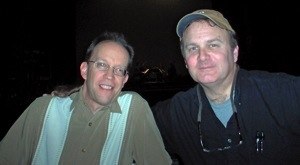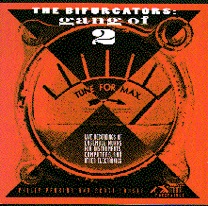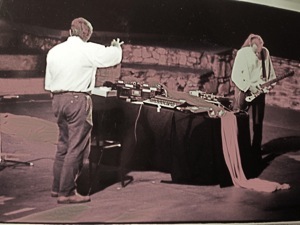
The Bifurcators was a project/partnership of Scott Fraser and Philip Perkins that began in 1973 and continued on and off until 2008. We started off by making several short films together, most notably RAIN (1973) and A RIVER (1975), and then turned to music and sound collaborations. For those we generally used a mix of traditional and electronic instruments, digital signal processors and computer timing and performance controls to find new links between preconceived ideas and serendipitous intuition in our live performance works. Our 2 CDs GANG OF TWO and LIKE A BIRD IN THE WILDERNESS are available from the composers, CDBaby and the Artifact Recordings Bandcamp website https://artifactrecordings.bandcamp.com/.

GANG OF 2 (Artifact # 1012 1995) with Doug Carroll, Tim Perkis and Bonnie Barnett Live recordings of ensemble works for instruments, computers and other electronics. The CD contains 4 works:
The Rose Window (1992) Philip Perkins: Computer controlled synths and sampler, pre-recorded materials, MIDI performance controls, signal processing, electronic noise makers, radios. Scott Fraser: Electric guitar. The concept for this work arose during several days spent watching the north Rose Window at the cathedral of Notre Dame in Paris. Inspired by the idea of the window as a vast visual chord, our thought in this work was to take a linear work of art like a piece of music and “turn the staff sideways” 90 degrees, thus allowing all the sounds in the work to be available all the time and the composers proceeding by finding new affinities among these materials within an equality of means. Here more than 30 note-rows are available to the players as triggerable MIDI sequences sent to various electronic instruments, which are also “listening” to Fraser’s guitar and various reflections and refractions of that guitar, and making complimentary pitches to accompany it.
Light On A Wall (1994) Scott Fraser: Electric guitar, Philip Perkins: Computer-controlled synths and signal processing, MIDI performance controls, Doug Carroll: Electronic cello, Tim Perkis: Computer-driven synthesizer. In “Light On A Wall” players try to incorporate ideas of slowness (just this side of motionlessness), inexorability, inevitability, and “sun-time” into their playing. Mental images include the angularity of light hitting a wall, various wall textures as the light plays and cascades over them, shadows and shapes created by the sun on the wall, and interruptions in the sunlight (clouds. trees etc.). Each player has a “shadow instrument” that listens to his note output and responds in a very specific way. The MIDI note stream is first examined by a piece of computer software which has been programmed with a sequence of scales that follow the time line of the work. These scales form “legal” note sets that the shadow instrument will play during that time period. When a player sounds one of these notes, the shadow instrument will sound that note also. Notes outside the current note set are ignored by the shadow instrument, thus the player decides how much he or she wants to “go along” with the direction of the work at any given moment. The note set changes approximately every minute or so, moving from 3 to 9 available notes by the end of each of two sections.
A New Work (1992) Philip Perkins: Computer-controlled synths and sampler, pre-recorded materials, MIDI performance controls, signal processing, electronic noise-makers, radios, mix, script. Scott Fraser: Electronic noise-makers, signal processing, electric guitar, edit. Bonnie Barnett: Voice (prerecorded). A New Work was presented as a live improvised performance over telephone lines from Philip Perkins’ studio in Albany CA to The Electronic Cafe International in Santa Monica CA on Jan. 11th 1992. The audio was designed to accompany a slow-scan video graphic work performed live by Tim Perkis and transmitted to Santa Monica at the same time. A script was read and recorded by Bonnie Barnett, and this recording drove a system of synths, samplers and other electronic devices under computer control in a highly interactive and fairly unpredictable manner. The original performance was co-produced by Kit Galloway.
White Eagles (1993) Scott Fraser: Electric guitar, Philip Perkins: MIDI performance controls, synths and sampler, pre-recorded materials, bowed electric bass. “White Eagles” is as simple and direct a memorial to the Bosnian War dead as we could muster. The work is intended to be dark and elegiac, with perhaps a trace of hope within the bitterness. We wanted the piece to be a lamentation for the work and victims of “irregular” militias the world over, but in the end we were overwhelmed by the images of the destruction of Sarajevo and her sister cities--these were the pictures that were in out minds as we performed. The title of the piece is the name of one particularly brutal “ethnic cleansing” brigade. The work is in three sections, separated by short silences.

LIKE A BIRD IN THE WILDERNESS (Artifact #1021 2001) with “Blue" Gene Tyranny, piano. Written specifically for pianist and composer “Blue” Gene Tyranny, and originally inspired by Wallace Stevens’ poem “Of Mere Being” (1955). Our composition reflected our observation of “Blue”’s playing style and sense of musical structure. We asked him to improvise on 5 related note-rows in sequence, but also asked him to feel free to depart from those rows as he saw fit. The computer-driven system that listened to and accompanied him was programmed for those rows, and much of it would only respond when he played around the specific note-row of the moment. Some other parts would record his musical gestures and then re-insert them into the piece, often modified, at a later time; while other parts listened to his playing and made new note rows and chords from that information, and still others played predetermined notes and chords that would play even if “Blue” did nothing at all. This was accomplished with a large number of simple “MAX” patchers running on two computers, which in turn played the several synths and samplers accompanying “Blue”. Some further notes: --You can never completely know what future effect an action will have. --Freedom of choice means living with the choices one makes. --Some things we do affect the future, some do not; some things will happen no matter what we do. (Composed 1994-7, recorded at Mills College, Oakland CA 1997)
Some uncollected works by The Bifurcators are available as downloads on Bandcamp: http://thebifurcators.bandcamp.com/track/home
notable live performances by The Bifurcators:
Jeremiah (Garden of Memory concerts, The Chapel of the Chimes, Oakland, 2007)
1219 (The Lab, San Francisco 1998)
The Hands Defeat (Mills College, Oakland 1994)
The Rose Window (KPFA, Berkeley, CA 1994)
White Eagles (John Anson Ford Theatre, Los Angeles 1994)
A New Work (transmitted via phone lines to The Electronic Cafe International, Santa Monica CA 1992)
Say Again Live broadcast work on KPFA, Berkeley CA 1991
Surface To Air (transmitted live via phone lines to radio stations in Berkeley, Boulder, and Toronto among others) 1990
Los Angeles Remote Live broadcast work on KPFK, Los Angles CA 1990, rebroadcast on Japanese, Canadian and Australian radio networks.

film music by The Bifurcators:
The Bifurcators contributed an excerpt from White Eagles (from the CD GANG OF 2) to the sound track of Rob Nilsson’s 2001 feature film SCHEME C6 (NineAtNight Films).
https://www.imdb.com/title/tt0300456/
more info about:
-works in progress (news)
-documentary film audio post projects
-music recording projects
-ballet and dance sound design projects
-dramatic film audio post projects
-odd and strange sound design projects
-solo albums, films and videos
-The Bifurcators
-what about production sound?
-bio
-HOME PAGE